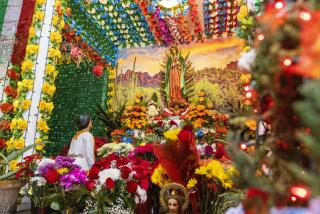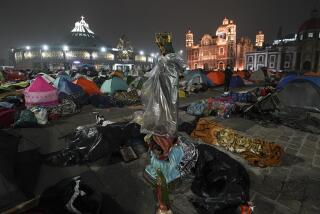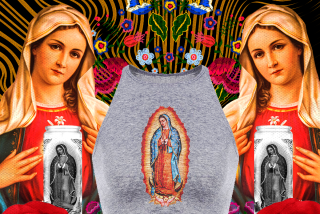‘Virgin of the Metro’--a Token of Holiness in Capital’s Subway
- Share via
MEXICO CITY — Word spread fast after a subway worker’s child noticed last week that a water stain on the floor of Mexico City’s bustling Hidalgo Metro station bore a miraculous likeness to the nation’s most powerful religious symbol, the beloved Virgin Mary of Guadalupe.
Thousands of Mexico’s faithful have since flocked to see the subway tile. They have even trekked from distant states, jostling with millions of commuters in the modern fluorescence of the downtown station to offer roses and coins, rub the stain for blessings or kneel, gape and weep over it in awe.
The scene has confounded subway officials, who have hired 25 guards to control the crowds, fenced off the spot and pasted up displays declaring, “It is not a miracle.”
Still, about 30 pilgrims a minute--50 a minute on weekends--visit the site, security officer Miguel Enriquez estimated. Many appear to share the view of homemaker Esperanza Sandoval Olgin, 47, who swore that a single pass over the stain cured her paralyzed right arm.
“It’s the Virgin,” she said tearfully. “Who else would it be? It is a miracle.”
Sightings of the Virgin of Guadalupe are not uncommon, said Fernando M. Gonzalez, a sociologist at the capital’s National Autonomous University of Mexico. This one, which has garnered unusual attention, including a media blitz that Mexico’s Roman Catholic Church has condemned, has put the church hierarchy in a tough spot.
The church long denied the existence of the Virgin of Guadalupe--until an Indian peasant who reported seeing her in 1531 produced a shroud bearing her image. The garment is now venerated by millions each year in Mexico City’s Basilica of Guadalupe. The Metro station where the image appeared is named after Miguel Hidalgo, the revolutionary priest of 1810 who adopted the Virgin of Guadalupe’s banner as his standard.
Mexico’s deep faith is grounded in such miracles. But reality must govern church policy, said Father Rogelio Alcantara, director of the Pastoral Education Commission of the Mexico City Archdiocese, which is handling an inquiry into the Virgin of the Metro.
“There are some established theological criteria” for proving miraculous apparitions, Alcantara said. They include the absence of natural explanations and the presence of a prophecy or message.
In preliminary findings last week, the archdiocese ruled: “There are no theological elements that permit us to confirm that there is a divine presence in these lines that were formed by a water leak.”
Alcantara said the stained tile is made of soft stone that absorbed, then expelled, leaking water. “In this case, there is a natural explanation,” he said.
Alcantara stressed, though, that the archdiocese respects the worshipers’ devotion. “We haven’t totally negated that it is a miracle,” he said.
The archdiocese’s statement also sought to broaden the debate: “We are surrounded by miracles for which we have lost the capacity to marvel: Conception and the birth of a child, a surgical operation, a laugh, a loyal friend, the harmony of the universe. . . . Yet we now see some undefined lines in the floor, and we are struck with wonder.”
Cesar Hernandez, 23, clearly was filled with wonder this week. After touching the stain, he said: “As a believer, I think this is something divine. . . . The church can think what it wants, and we, the believers, are free to think what we want.”
More to Read
Sign up for Essential California
The most important California stories and recommendations in your inbox every morning.
You may occasionally receive promotional content from the Los Angeles Times.










